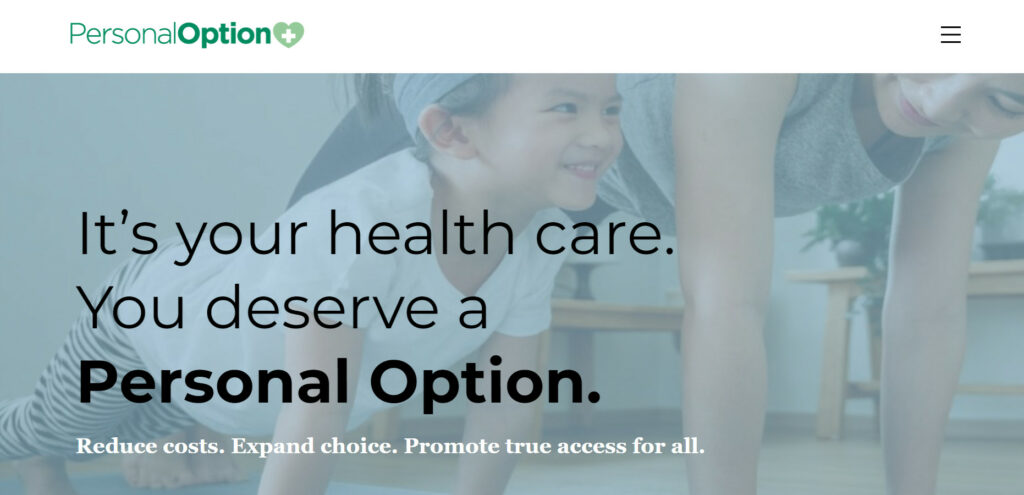
Why 90% of Americans lack access to health savings accounts
Tax-free health savings accounts save money, reduce medical inflation, and give patients more choice and control. Expanding access to HSAs is key to reducing medical inflation and giving Americans more personalized options in health care.
Unfortunately, 90% of Americans have no access to this powerful financial tool. An invisible ceiling exists that keeps most people shut out. That is an injustice.
Thankfully, we can restore justice. We can remove the ‘HSA ceiling’ and create universal HSA access.
Here’s why the HSA ceiling exists, why it matters, and how we can remove it.
What is an HSA?
To understand why HSA expansion is essential, it is helpful to understand how HSAs work.
An HSA is like a bank account or 401(k) for health care. The money in the account is completely tax-free if it is used for qualified medical expenses like prescriptions and medical procedures. Any unspent funds at the end of the year roll over to the next year and can be saved or invested to cover future medical expenses.
Having an HSA saves people money. The funds are never subject to federal income or payroll taxes. Contributions, interest, and withdrawals are all tax-free. This unique triple-advantage gives HSA owners the equivalent of a generous price discount on every medical purchase.
Having an HSA provides peace of mind. Families can use the money to cover health care expenses between jobs and, importantly, to buy things their health plan does not cover.
An HSA is a safety net. While it is not always a substitute for an insurance policy, it is a vital supplement. In fact, it can be a lifesaver. Thanks to today’s relentless medical inflation and onerous government rules, insurance companies are increasingly stinting on coverage, throwing up barriers to the latest therapies, and limiting access to the best doctors and facilities.
Right now, HSA account balances exceed $100 billion nationally, or about $3,000 per account on average. But those savings are enjoyed by only a minority of Americans, the “lucky 10%.” The rest of us are shut out.
Why it matters that people have access to HSAs
How do HSAs help society? Two big ways.
First, they help reduce costs and improve quality of care by giving patients more choice and control over their medical decisions. They help turn patients into consumers and shoppers.
Second, studies suggest HSAs help reduce overall health care spending without causing patients to forgo preventive care. (See some of those studies here, here, here, and here.)
This makes sense. People tend to spend more wisely when spending their own money. And they invest in preventive care because staying healthy today means having more money in your account tomorrow, when you might need it for a big, unexpected expense.
Every American should have access to this powerful financial tool.
The HSA ceiling: Why 90% of Americans have no access to HSAs
Unfortunately, right now, according to IRS data, only about one in ten Americans has an HSA, or about 33 million people. And that percentage is unlikely to rise — ever — without an act of Congress.
Why? Because of unnecessary government rules.
Under current law, a taxpayer may not contribute to an HSA unless he or she also has an HSA-qualified health insurance plan (officially called a high-deductible health plan or HDHP).
Because of this requirement, the uninsured are shut out of HSA access categorically and by design. They total about 9% of the U.S. population.
At the same time, most health insurance plans sold today are not HSA-qualified.
To be HSA-qualified, a plan must be a high-deductible health plan as defined in federal law. The plan must include a certain minimum deductible and a certain maximum out-of-pocket limit and must follow specific rules regarding how the deductible is applied.
Which creates two problems.
First, most federal health care programs, including Medicare, Medicaid, Tricare, and the Indian Health Service, do not meet the definition of an HDHP. All those people are HSA-ineligible. (Adding insult to injury, people over age 65 are excluded from HSAs as a class. Medicare seniors with an existing HSA account are allowed to spend down the money in the account, but not to add more.)
Second, most insurers do not bother to offer an HDHP because most consumers do not want one. (Are we surprised? Politicians designed it.)
Additionally, a taxpayer may not contribute to an HSA if he or she has more than one health plan. This renders people ineligible for an HSA who, for perfectly legitimate reasons, rely on more than one health plan.
This one-plan-only rule also renders people ineligible for an HSA who rely on innovative, insurance-free care models like direct primary care (DPC).
The IRS views these models as forms of health coverage, which is incorrect — they are care. Yet today simply having a DPC subscription makes you HSA-ineligible.
We can now determine two statistics.
First, 41% of the U.S. population relies on coverage that is never HSA-qualified:
- Medicare (18%)
- Medicaid (17%)
- Tricare (3%)
- VA health care (2%)
- Indian Health Service (1%)
Second, of the remaining 59% of the population, 52% lack access to a plan that is HSA-qualified:
- Employer-sponsored insurance (ESI) (45%)
- Individual market plans (5%)
- The uninsured (2%)
Add those two figures together, and you get 93%.
I have excluded 7 percentage points from the uninsured figure, because they are eligible for some form of health coverage but have not bothered to enroll. I’ve also rounded all the figures above for simplicity and done my best to avoid double-counting.
Now, you may be asking yourself: “Why don’t employers and private insurers just offer HSA-qualified coverage?” They could, and a few do — but only a few.
Employers:
By my calculation, only 12% of employers offer HSA-qualified coverage, and fewer than 10% of employees (fewer than 5% of Americans) work for an employer who offers such coverage.
(Note: This is my own estimate. I derived it as follows.
First, about 35% of Americans are offered health benefits at work. (There are 333 million Americans, of whom 48% are employed (160 million employees), of whom about 73 percent (117 million employees) have an offer of workplace coverage. 117 million is 35% of the U.S. population.)
Second, only about 12% of firms offer an HSA-qualified plan. (About 60 percent of U.S. firms offer health benefits, but only about 20 percent of those firms offer an HSA-qualified plan, and 20% of 60% is 12%.)
Third, to be conservative, disregard the fact that HSA offers are concentrated among larger employers with more than 500 employees, but instead, assume that offers are distributed evenly across all employer types.
Finally, multiply 117 million by 12% and you get 14 million people. Fourteen million is about 8.7 percent of employees and about 4.2% of all Americans. And if my assumption in point three is wrong, and the correct multiplier is less than 12%, then these percentages are even lower.)
Individual market:
While insurers are free to offer HSA-qualified products in the individual insurance market, few do so. And their HSA-qualified offerings are usually overpriced and uncompetitive with non-HSA-qualified offerings.
Why can’t we assume that every consumer who purchases coverage in the individual market has access to at least one affordable HSA-qualified plan in his or her area? Can’t we just assume everyone in that market has HSA access?
That assumption is not entirely unreasonable, but even if it is true, which I doubt, only around 5% of Americans obtain their coverage in the individual market, which would move the number of people with no effective access from 93% to 88%.
That 5% figure is unlikely to grow, thanks to government mandates and distorted subsidies that cause individual coverage to be overpriced generally.
How to remove the HSA ceiling and expand HSA access to more people
All right. So how do we remove the HSA ceiling?
Option A: decoupling
The best and cleanest way to remove the HSA ceiling is to decouple HSAs from insurance altogether, which would also obviate any need for a one-plan-only rule. This simple reform would enable all Americans, including the uninsured, to have an HSA. Problem solved.
Now, there are two reasons why Congress might hesitate to decouple completely.
1) They might want to maintain a requirement to be insured, while wanting to make that requirement less prescriptive. (In which case, they could take Option B below.)
2) They might want to reduce the impact on the federal treasury. (In which case, they should go with Option C or D.) Recall that HSA funds are never taxed. When the amount of money saved and spent through HSAs goes up, the amount of tax money collected by the IRS goes down.
Option B: actuarial deeming
In this option, Congress deems any kind of insurance plan with an actuarial value of, say, 80% or below as HSA-qualified. This would make most forms of insurance HSA-compatible (good) but would also leave the uninsured without HSA access (bad). It would slightly reduce revenue loss.
Option C: categorical deeming
A third, and more budget-friendly, approach would be to categorically deem specific, existing forms of standard coverage as HSA-qualified, in waves, over time.
For example, Congress could deem individual-market plans qualified as of date A, Medicare as of date B, Medicaid as of date C, and ESI as of date D, spreading these dates over a period of years. And just to be safe, it could make each wave contingent on the deficit being below some specified level on the respective date.
Option D: true reform
A creative (and beneficial way) to eliminate the reform’s cost would be to transform the current federal tax break for employer-sponsored insurance (nearly $300 billion a year at present) into a more robust version of today’s tax break for employer contributions to HSAs.
This would incentivize employers to shift from sponsoring costly, nonportable, and employer-owned group health benefits to providing portable, employee-owned HSA cash contributions. It would not only encourage a lot more people to want an HSA, it would also encourage people to use insurance only for what they need, reducing health care costs for everyone.
This is the approach taken, for example, in Texas Representative Chip Roy’s elegantly drafted Healthcare Freedom Act. Congress could use some of the money saved by this reform to fund the HSAs of low-income Americans.
Other needed health care reforms
Regardless of how we expand HSA access, we should also make two other critical changes:
Legalize direct primary care
Congress should specify that a DPC membership does not constitute a second, forbidden health plan, for purposes of HSA eligibility.
Congress should also ensure that HSA funds may lawfully be used for DPC subscriptions, which is currently prohibited. DPC is an innovative, subscription-based model of care delivery in which patients can obtain virtually unlimited access to medical care, lab tests, referrals, and (often deep) discounts on generic drugs — all for one low monthly fee. Every American should have access to this exciting new option.
Increase the current HSA contribution limit
Congress should also increase how much money can be deposited into an HSA each year. For tax year 2022, a taxpayer may not contribute more than $3,650 (or $7,300 if it is a joint return). That is way too low. Ideally, we would at least triple it.
Right now, the one-year deductible of an average Affordable Care Act-compliant health plan exceeds $10,000. We need to de-link HSA eligibility from insurance, but not necessarily HSA contribution levels.
Now is the time to expand access to HSAs
The case for HSA expansion is persuasive. The need for it is urgent.
Removing the HSA ceiling is no longer a luxury, it is a practical necessity — with health care prices soaring, and access to trusted medical professionals shrinking. In today’s environment, we should be taking every reasonable step to empower individuals and families to afford care, save money, and shop for value.
Morally, the fact that 90% of Americans cannot have an HSA is a major injustice that must be addressed if we genuinely want to reduce health care costs and make our health care system more responsive to patients.
The right to save and spend for health care tax-free should be available to all of us — not just the lucky 10%.
Visit personaloption.com today to learn how you can take charge of your health care.



